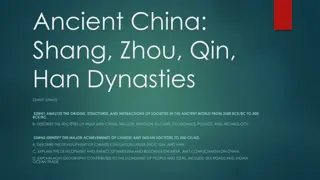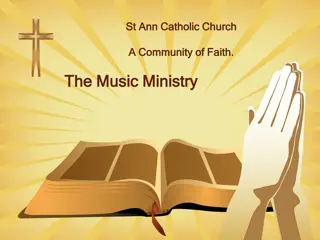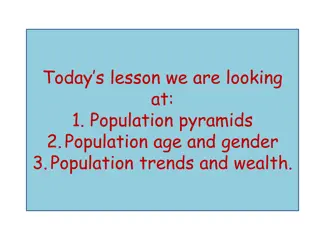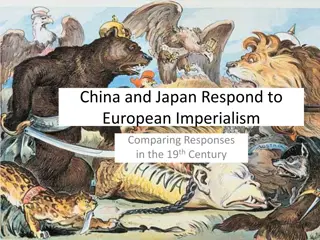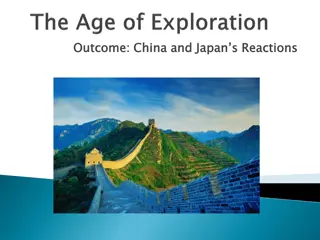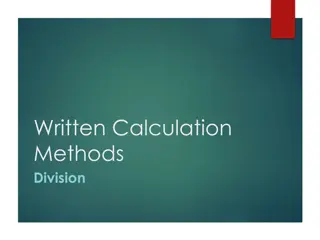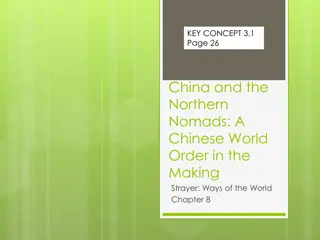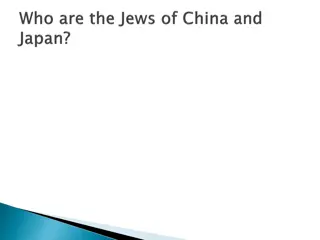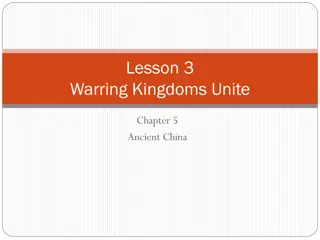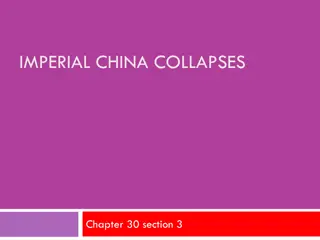Fascinating Facts About China: People, Culture, and Celebrations
China, officially known as the People's Republic of China, boasts the world's largest population and a rich cultural heritage. Explore details about its cities, economy, space achievements, the Great Wall, and the vibrant celebrations of Chinese New Year, including the Dragon Dance Parade. Discover the significance of Chinese New Year and its varying dates alongside festive traditions.
Download Presentation

Please find below an Image/Link to download the presentation.
The content on the website is provided AS IS for your information and personal use only. It may not be sold, licensed, or shared on other websites without obtaining consent from the author. Download presentation by click this link. If you encounter any issues during the download, it is possible that the publisher has removed the file from their server.
E N D
Presentation Transcript
. China is officially known as the People's Republic of China. China has the largest population in the world, with a population of over 1.3 billion people. China belongs to the continent of Asia. Bordering countries include Afghanistan, Nepal, Burma and India.
The capital city is Beijing, while the most populated city is Shanghai. Other major cities include Chongqing, Shenzhen and Guangzhou. 47% of the population live in urban areas. China experiences typhoons every year and also suffers from floods, earthquakes and droughts.
China is the second largest economy in the world, after America. In 2003, China became the third country to successfully send a person to space. The Great Wall of China is the largest man made structure in the world, stretching an incredible 8,850 kilometres.
Chinese New Year: This traditional feast has been celebrated for more than four thousand years. It came about from ancient celebrations to mark the end of the long winter season and the beginning of spring. It celebrates the earth coming back to life and the beginning of the growing cycle.
Chinese New Year 2016 will be on February 8, 2016 ! In western countries, New Year's Day always falls on January 1st. In China, New Year's Day is also the first day of the first month of the Lunar Calendar. Therefore, Chinese New Year dates vary each year and could fall at the end of January or in February. The New Year celebrations begin on New Year's Eve, the big party is on New Year's Day, and the action continues for the next 15 days. It all ends with the first full moon of the year, fifteen days later with the Lantern Festival.
The people of China celebrate in many ways. One being the Dragon Dance Parade which brings good luck and prosperity for the coming year and is an essential ingredient of any Chinese celebration, especially the Lunar New Year. The Dragon Dances begin on New Year's Day, and continue throughout the festivities for the next fifteen days. A cloth dragon is held on poles by a team of a dozen people who make the dragon "dance" by raising and lowering the pole!
Fireworks Displays are a staple of a Chinese New Year celebration.
The most common way to wish someone a Happy New Year is by saying Gong Xi Fa Gong Xi Fa Cai Cai in Mandarin or Gong Hey Fat Choy Gong Hey Fat Choy in Cantonese
The New Year Celebrations can only begin after paying respect to the ancestors. On New Year's Eve, people will go to the temples and pray for good fortune for the new year. They bring offerings of food and incense to please the spirits of the deceased so that they might bring good luck. They come to ask for a special favour perhaps, or just to appease the spirits if luck hasn't been that great lately.
Each year of the Chinese New Year calendar is named after an animal. This is a 12 year cycle. Once the 12 year cycle is over the animal list begins again. The list in order is: rat, ox, tiger, rabbit, dragon, snake, horse, ram, monkey, rooster, dog, and pig.
Children receive red envelopes full of money instead of wrapped gifts that other nationalities give at Christmas. The amount they receive is usually an even number. The amount cannot be divisible by four. In Chinese, the number 4 means death.
The Lantern Festival takes places on the fifteenth day. Children and adults display lanterns they have made during the parade. The festival is associated with guiding lost and ill bred evil spirits home, while celebrating and cultivating positive relationship between people, families, nature and the higher beings as they are believed to be responsible for bringing and returning the light each year. Another legend associates the Lantern Festival with Taoism. Tian Guan is the Taoist 'Ruler of Heaven' and the God responsible for good fortune, bestowing wealth and good luck. His birthday falls on the 15th day of the first lunar month. It is said that Tian Guan likes all types of entertainment, so followers prepare various kinds of activities during which they pray for good fortune.
Teaching Points: Compare and contrast the Chinese New Year with how we celebrate New Year s in Ireland. Demonstrate and discuss the importance of traditions and customs to countries and citizens. -Students will locate the year they were born on a Chinese zodiac chart and determine if the characteristics of the animals are an accurate portrayal of their personalities. Debate: Do you think it is okay for the children in China to get two weeks holidays from school to celebrate the new year? Write a letter to a pen pal in China and ask her about her plans for the Chinese New Year. Tell him/her what you have learned about their customs. Write an account of the Chinese New Year, as witnessed by an RTE news reporter.
Question Time: Where is China? What is China s population? Which countries border China? Can you tell me one interesting fact about China? When does the 2016 Chinese New Year take place? What does the Chinese New Year signify? Can you name three activities Chinese people take part in during the Chinese New Year? What do the animals mean? What do children receive during the Chinese New Year?










